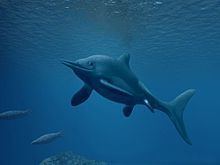Kingdom Animalia Family †Ophthalmosauridae Species †A. densus Rank Genus | Class Reptilia Subfamily †Ophthalmosaurinae Phylum Chordata Order Ichthyosaur | |
 | ||
Similar Ichthyosaur, Aegirosaurus, Malawania, Ophthalmosauridae, Caypullisaurus | ||
acamptonectes densus
Acamptonectes is an extinct genus of ophthalmosaurid ichthyosaur known from England and Germany. It was collected from the Hauterivian stage of England and Germany and from the Cambridge Greensand Formation, eastern United Kingdom, dating to late Albian or early Cenomanian stage, of the Early Cretaceous-Late Cretaceous boundary. Acamptonectes was first described by Valentin Fischer, Michael W. Maisch, Darren Naish, Ralf Kosma, Jeff Liston, Ulrich Joger, Fritz J. Krüger, Judith Pardo Pérez, Jessica Tainsh and Robert M. Appleby in 2012 and the type species is Acamptonectes densus.
Contents
Description
Acamptonectes is known from several specimens: the holotype adult, a partial sub-adult, and an additional partial skeleton. The holotype consists of a fragmentary skull roof, a complete mandible, a partial axial skeleton and a partial scapular girdle. Acamptonectes is similar in morphology to the related but earlier ophthalmosaurids Ophthalmosaurus and Mollesaurus.
Acamptonectes is morphologically distinct from other ophthalmosaurines in a variety of ways. Its binomial name, meaning "tightly-packed rigid swimmer", refers to the tightly-packed occipital bones and cervical vertebrae that would have allowed little movement in the neck, indicating it must have "shot through the water like a dart." Most of its skeleton appears to be unusually rigid, which would have in effect severely limited the amount of side-to-side motion that was possible in the anterior part of the skeleton. Its snout is also shallower and its teeth more slender-crowned and sharply pointed than related species, and its ribs are also more robust rounded in cross-section, which may be a further adaptation to increase the stiffness of the animal's body, as they were likely more resistant to bending. Like other ichthyosaurs, Acamptonectes was a predator and probably fed on fish and squid, and its overall body plan would have been similar in appearance to that of a dolphin. It was approximately 3 meters (10 ft) in length.
History of discovery
The first and most complete specimen of Acamptonectes was discovered in 1958 in the Speeton Clay formation of North Yorkshire in England, but its description was never formally published. At the time, its describer regarded the fossil as a new species of Platypterygius, another genus of ophthalmosaurid ichthyosaur. In 2003, a new ophthalmosaurid ichthyosaur was discovered in Cremlingen, Germany. This was determined to be a new taxon, and the characteristics unique to it were also determined to exist in the 1958 Speeton Clay "Platypterygius". A second Speeton Clay specimen was discovered in 1985. Ultimately, a collaboration was created amongst the various scientists who had studied these three specimens, and the taxon was formally named in 2012, using the original 1958 specimen (which was determined with certainty not to represent Platyptergius after all) as the holotype and the two later finds as paratypes. Ichthyosaurus brunsvicensis described in 1909 was regarded as cf. Acamptonectes in the 2012 study.
Evolution
Acamptonectes is a significant find in that it demonstrates that the more specialized ichthyosaurs were not entirely wiped out at the extinction marking the end of the Jurassic period, which up until now had been the common interpretation of the fossil record for this clade. The discovery of Acamptonectes indicates that ophthalmosaurids remained diverse until their total extinction at the end of the Cretaceous. The phylogenetic analysis performed by Fischer et al. indicates that the Ophthalmosauridae family underwent an early divergence into two very different subfamilies, Ophthalmosaurinae and Platypterygiinae. Both clades crossed the Jurassic-Cretaceous boundary and lasted at least until the Albian of the early Cretaceous.
